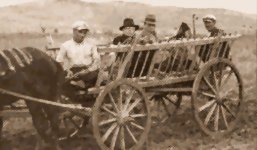
Bela Bartok
Folk music is an elusive thing. By its very nature, it is not written down,
rarely recorded and until recently, rarely performed for a general audience.
It is therefore not surprising that people searching for
authentic
folk music often get it wrong.
In the Nineteenth century, Lizst and Brahms promoted their
Hungarian Rhapsodies
and
Hungarian Dances as true Hungarian folk music. While wildly
popular with the public, these pieces were actually poor reproductions
of Hungarian gypsy melodies and stereotyped Hungarian motifs.

Bartok (in black hat) researching folk music.
As a young man, Bela Bartok set out into the countryside of his homeland Hungary
and neighbouring Romania with an Edison phonograph and an open mind. What
he found there astonished him. Not only did true Hungarian folk music bear
little resemblance to the Viennese parlour versions, but the richness,
variety, energy and exhuberance of it set his life-course. Bartok was a
musicologist and an ethnographer before he became a composer. He was afraid
that with the changing of society, this music may become lost to the world
forever. He recorded over 2000 phonograph rolls of folk people performing
their own music, studied it intensely, and later based his own compositions
on this rich legacy.
The Bartok Album includes 3 of Bartok's original phonograph recordings, original voices from almost 100 years ago singing the music of their land. The sound is scratchy and weak, but their honesty, love of life and even their self-consciousness at being recorded still comes through today.
These three folk recordings are followed by Bartok's transformation of them into serious music. Three exerpts from
Duos for Violin are interpretations of pieces collected from his travels. Distincly Hungarian but also distinctly Bartok; the link from the original to fine art, from the open plains to the concert hall is a fascinating revelation of a composer's inspiration.
The
Duos in turn are followed by Muzsikás' folk music ensemble arrangements of the same pieces again, and others. We are back on the land, perhaps at a country wedding. The dances are lively and fun. The rhythms and harmonies are sometimes complex and unexpected. Others, like the Shepherd's Flute Song, are serene and contemplative. But always the music is genuine.
Muzsikás is the best-known Hungarian folk music group, even more so since its lead singer Marta Sebestyen featured in the soundtrack to the movie
The English Patient. Their instruments include cymbalom (a type of dulcimer), wood flutes, violins and their own clapping, foot-stamping and voice embelishments. Only a Hungarian folk music group can play Hungarian folk music with such energy and passion.
But you don't have to be Hungarian to enjoy it.
Please support Good-Music-Guide.com
by purchasing this CD using this link.

Track Listing
Muzsikas - The Bartok Album
With Marta Sebestyen, Alexander Balanescu
- Dunantuli Friss Csardasok
- Jocul Barbatesc
- Violin Duo No. 32, Bela Bartok
- Maramaros Dances
- On the River Bank
- Swineherds' Dance
- Dunantuli Ugrosok
- Shepherd's Flute Song
- Forgacskuit Lads' Dance
- My Horse's Shoe
- Violin Duo No. 28, 'Sorrow', Bela BArtok
- Bonchida: Slow Lads' Dance
- Magyarbecei Oreges Csardasok
- Pe Loc
- Bota Dance
- Torontal Dances
- Ardeleana
- Violin Duo No. 44, 'Transylvanian Dance', Bela Bartok
- Fuzes: Lads' Dance
- The Churchyard Gate
- Kalotaszeg Dances
- I Left My Homeland